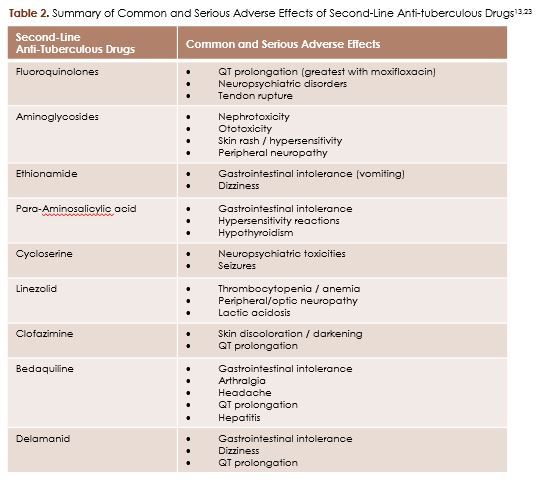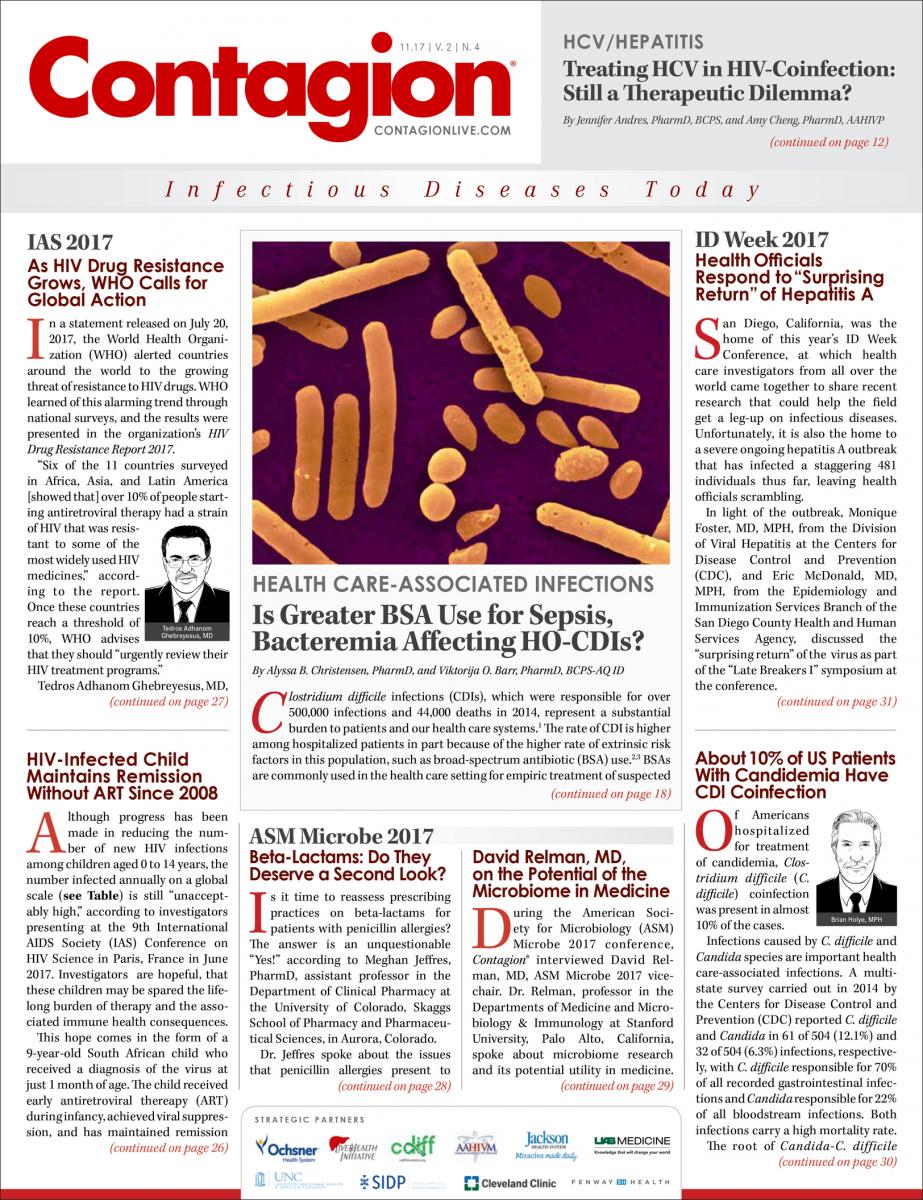Exploring the Threat of MDR-TB in the United States
The virulent pathogen has significant individual and public health implications.
Tuberculosis (TB) has been labeled as one of the deadliest infectious diseases to humankind. Advances in Mycobacterium tuberculosis (MTB) research, coupled with the discovery of the antituberculous medications isoniazid and the rifamycins, propelled multiple international efforts to control TB that drastically changed the disease landscape.1 Yet, per the World Health Organization (WHO), 10.4 million TB cases occurred in 2015, ranking the infection among the top 10 causes of death worldwide.2
A major threat to global TB control is drug-resistant disease. Treatment for drug-sensitive TB involves prolonged combination therapy—usually at least 6 months of multidrug treatment—because of MTB’s inherent ability to evade host defense mechanisms.3 Inadequate treatment (eg, from inappropriate drug administration or nonadherence) may lead to resistance. Additionally, resistant TB strains may infect and cause disease in individuals not previously exposed to antituberculous therapy. Accordingly, the WHO, with support from the International Union Against Tuberculosis and Lung Disease, established the Global Project on Anti-Tuberculosis Drug Resistance Surveillance, the oldest and largest initiative of antimicrobial resistance surveillance in the world.4
The most serious forms of drug-resistant TB include rifampin-resistant TB (RR-TB), multidrug-resistant TB (MDR-TB), and extensively drug-resistant TB (XDR-TB). MDR-TB is defined as TB with resistance to at least isoniazid and rifampin, the most effective anti-TB drugs.5 XDR-TB is defined as MDR-TB also resistant to any fluoroquinolone and at least 1 injectable agent.5 MDR- and RR-TB account for about 3.9% of new TB cases and 21% of previously treated cases, totaling 580,000 incident cases and 250,000 deaths per year.2 Areas of Eastern Europe and Central Asia, however, remain locations of MDR-TB epidemics, with incidence rates reaching 34%.4 Furthermore, the true global burden is likely underestimated, given underreporting, lack of universal resistance testing, and undiagnosed TB disease, especially in areas with geographic or financial barriers to care.2,6
DISEASE BURDEN IN THE UNITED STATES
In the United States, 9287 cases of TB were reported in 2016, contributing to an incidence rate of 2.9 cases per 100,000 persons.7 Seemingly reassuring, the small magnitude of incidence decline from the prior year predicts that national elimination of TB will not occur during this century.7
Demographically, roughly two-thirds of TB cases occurred in foreign-born individuals, with the highest incidence in Asians (26.9 cases per 100,000).7 California, Florida, New York, and Texas accounted for over 50% of cases.7 A source case study of national TB cases between 2011 and 2014 indicated that the vast majority were presumably due to reactivation of latent TB infection.8
Fortunately, MDR-TB remains relatively rare in the United States. The most recent MDR-TB data, from 2015, include 88 cases, representing about 1% of persons with TB disease.9,10 Eighty-five percent were foreign-born persons, and nearly 82% were individuals without a history of TB disease.7,9 These statistics emphasize how global control will undoubtedly affect progress toward national TB elimination.
FINANCIAL IMPLICATIONS AND RESOURCE UTILIZATION
MDR-TB requires extended courses of medications that are more expensive, less effective, and often more toxic than first-line treatment for drug-sensitive TB, thereby imposing a significant financial burden on patients and health care systems. Marks and colleagues analyzed costs of treatment for MDR and XDR-TB in high-risk areas of the United States from 2005 to 2007.11 Treatment duration ranged from 20 to 32.3 months, depending on resistance profiles, and 73% of patients were hospitalized at least once during their treatment. Average direct costs were $134,000 per MDR-TB patient and $430,000 per XDR-TB patient; direct-plus-productivity-loss costs averaged $260,000 to $554,000. The extrapolated total direct-plus-productivity- loss costs to the US health care system were approximately $100 million. A follow-up study indicated that 98 of 135 MDR-TB patients were hospitalized during treatment, averaging 1.5 hospitalization episodes per patient and an average duration of 94 days.12 The most common reasons for hospitalization were severe worsening of TB and the need to initiate or change treatment regimens. Risk factors for more frequent hospitalization included being age 65 years or older, having AIDS, and having private insurance. The average cost per hospitalization was $54,883 for MDR-TB and $191,374 for XDR-TB— among the highest for any disease in the United States.
DIAGNOSIS
Drug-resistant TB is diagnosed by identifying MTB and then performing drug-susceptibility testing (DST).13 DST is often limited to state or other specialized laboratories, and final test results may be delayed by up to several weeks. Recent data suggest that despite improvements, incomplete and/or delayed DST results persist in the United States.14
Also concerning is reduced disease suspicion due to unfamiliarity of US health care providers with TB, leading to delayed or missed diagnoses and health care worker exposure. A study of pulmonary TB in New York, New York, from 2010 to 2014 sought to capture and quantify this risk.15 The average time between admission and placement on airborne isolation was 3.3 days, and the average time between admission and diagnosis was 5.1 days. This led to an average of 41 staff members’ requiring exposure-related follow-up per patient and nearly 40 hours of infection control workload.
TREATMENT OUTCOMES
The WHO estimates a global treatment success rate (defined as the sum of cure and treatment completion) of 52% in MDR- and RR-TB patients, compared with 85% for drug-susceptible disease.2 Outcomes from an aforementioned study in the United States reported an MDR-TB treatment completion rate of 78% (n = 134), with no failures or recurrences within 1 year.11 Twelve (9%) deaths occurred during treatment, of which 75% were attributable to TB. Death was associated with an age range of 65 years and above, smoking, and HIV infection.
Medication accessibility and drug toxicity are other key safety outcomes. A 2010 survey indicated 81% of health departments reported difficulty obtaining second-line agents for MDR-TB.16 In a report from 5 international WHO sites, 30% of patients required cessation of a suspected drug(s) because of toxicity, and 2.1% stopped treatment entirely because of adverse effects.17 The Centers for Disease Control and Prevention reports that 19% of patients treated for drug-resistant TB in the United States experience depression or psychosis, 13% develop hearing impairment or hepatitis, and 11% experience kidney injury.18 Recently, shorter-course regimens have been introduced, with improved treatment success rates and associated safety profiles.19,20 Though a complete review of treatment exceeds the scope of this review, the WHO MDR-TB guidelines and common medication toxicities are summarized in Tables 1 and 2.
PREVENTION STRATEGIES
Prevention strategies are key to minimizing and eliminating the transmission of both drug-sensitive and drug-resistant TB. US public health departments are tasked with TB control, particularly to ensure prompt diagnosis and completion of appropriate treatment. Programs also provide transportation and childcare assistance, food and housing incentives, directly observed therapy, and alternative treatment delivery sites to optimize treatment success.21 In December 2015, the National Action Plan for Combating Multidrug-Resistant Tuberculosis was released to identify targeted interventions and address domestic and global challenges associated with resistant TB.22 The plan outlines 3 broad goals to combat MDR-TB, including (1) strengthening domestic capacity, (2) improving international capacity and collaboration, and (3) accelerating basic and applied research and development.22 This intervention solidified the investment and coordination of government resources for this important cause.
Although seemingly uncommon in the United States, drug-resistant TB has significant individual and public health implications. Limitations in disease surveillance, DST, medication access, and patient management remain. Government programming, scientific research, and health care professionals must collaborate in optimizing MDR-TB diagnosis, treatment, and monitoring. A significant joint effort will be required for global eradication of tuberculosis.


Dr. Bailey is an assistant professor at the Notre Dame of Maryland University School of Pharmacy and a clinical specialist in infectious diseases/ internal medicine at the University of Maryland Medical Center (UMMC). She earned her PharmD at the University of Maryland School of Pharmacy (UMPharm) and completed 2 years of postgraduate residency training at UMMC/UMPharm.
Dr. Saleeb is an assistant professor at the University of Maryland School of Medicine. He earned his MD degree at the University of Texas Southwestern Medical Center at Dallas, and he completed his internal medicine residency training at MedStar Georgetown University Hospital and his infectious diseases fellowship training at the National Institute of Allergy and Infectious Diseases.
References
- Daniel TM. The history of tuberculosis. Respir Med. 2006;100(11):1862-1870.
- World Health Organization. Tuberculosis: global tuberculosis report 2016. http://www.who.int/tb/publications/global_report/en/. Published 2016. Accessed June 19, 2017.
- Nguyen L. Antibiotic resistance mechanisms in M. tuberculosis: an update. Arch Toxicol. 2016;90(7):1585-1604. doi: 10.1007/s00204-016-1727-6.
- Zignol M, Dean AS, Falzon D, et al. Twenty years of global surveillance of antituberculosis-drug resistance. N Engl J Med. 2016;375(11):1081-1089. doi: 10.1056/NEJMsr1512438.
- World Health Organization. Multidrug-resistant tuberculosis (MDR-TB) Factsheet: 2016 update. www.who.int/tb/challenges/mdr/mdr_tb_factsheet.pdf. Published 2016. Accessed June 22, 2017.
- Nourzad S, Jenkins HE, Milstein M, Mitnick, CD. Estimating the global burden of multidrug-resistant tuberculosis. Int J Tuberc Lung Dis. 2017;21(1):6-11. doi: 10.5588/ijtld.16.0110.
- Schmidt KM, Wansaula Z, Pratt R, Price SF, Langer AJ. Tuberculosis — United States, 2016. MMWR Morb Mortal Wkly Rep. 2017;66(11):289-294. doi: 10.15585/mmwr.mm6611a2.
- Yuen CM, Kammerer JS, Marks K, Navin TR, France AM. Recent transmission of tuberculosis — United States, 2011-2014. PLoS One. 2016;11(4):e0153728. doi: 10.1371/journal.pone.0153728.
- CDC. Fact Sheet: Trends in Tuberculosis, 2015. www.cdc.gov/tb/publications/factsheets/statistics/tbtrends.htm. Updated November 29, 2016. Accessed June 19, 2017.
- CDC. Fact Sheet: TB Drug Resistance in the U.S. www.cdc.gov/nchhstp/newsroom/docs/factsheets/tb-drug-resistance-factsheet.pdf. Published October 2015. Accessed June 19, 2017.
- Marks SM, Flood J, Seaworth B, et al. Treatment practices, outcomes, and costs of multidrug-resistant and extensively drug-resistant tuberculosis, United States, 2005-2007. Emerg Infect Dis. 2014;20(5):812-821. doi: 10.3201/eid2005.131037.
- Marks SM, Hirsch-Moverman Y. Salcedo K, et al. Characteristics and costs of multidrug-resistant tuberculosis in-patient care in the United States, 2005-2007. Int J Tuberc Lung Dis. 2016;20(4):435-441. doi: 10.5588/ijtld.15.0575.
- World Health Organization. WHO treatment guidelines for drug-resistant tuberculosis: 2016 update. http://apps.who.int/iris/bitstream/10665/250125/1/9789241549639-eng.pdf?ua=1. Accessed September 13, 2017.
- Jones NM, Armstrong LR. Delayed and unreported drug-susceptibility testing results in the US National Tuberculosis Surveillance System, 1993-2014. Public Health Rep. 2017;132(4):480-487. doi: 10.1177/0033354917708989.
- Kelly AM, D’Agostino JF, Andrada LV, Liu J, Larson E. Delayed tuberculosis diagnosis and costs of contact investigations for hospital exposure: New York City, 2010-2014. Am J Infect Control. 2017;45(5):483-486. doi: 10.1016/j.ajic.2016.12.017.
- Centers for Disease Control and Prevention. Interruptions in supplies of second-line antituberculosis drugs — United States, 2005-2012. MMWR Morb Mortal Wkly Rep. 2013;62(2);23-26.
- Nathanson E, Gupta R, Huamani P, et al. Adverse events in the treatment of multidrug-resistant tuberculosis: results from the DOTS-Plus initiative. Int J Tuberc Lung Dis. 2004;8(11):1382-1384.
- CDC. The costly burden of drug-resistant TB in the U.S. www.cdc.gov/nchhstp/newsroom/docs/factsheets/costly-burden-dr-tb-508.pdf. Published October 2016. Accessed June 22, 2017.
- Aung KJM, Van Deun A, Declercq E, et al. Successful ‘9-month Bangladesh regimen’ for multidrug-resistant tuberculosis among over 500 consecutive patients. Int J Tuberc Lung Dis. 2014;18(10):1180-1187. doi: 10.5588/ijtld.14.0100.
- Van Deun A, Maug AK, Salim MA, et al. Short, highly effective, and inexpensive standardized treatment of multidrug-resistant tuberculosis. Am J Respir Crit Care Med. 2010;182(5):684-692.
- Institute of Medicine Committee on the Elimination of Tuberculosis in the United States. Ending Neglect: The Elimination of Tuberculosis in the United States. L. Geiter, ed. Washington, DC: National Academies Press; 2000.
- The White House National action plan for combating multidrug-resistant tuberculosis. https://obamawhitehouse.archives.gov/sites/default/files/microsites/ostp/national_action_plan_for_tuberculosis_20151204_final.pdf. Published December 2015. Accessed June 24, 2017.
- The Johns Hopkins University. The Johns Hopkins POC-IT ABX Guide. 2017. Unbound Medicine, Inc. Baltimore, MD. Auwaerter PG, Bartlett JG, Dzintars K, Avdic E, Smith J, Hsu AJ eds. Accessed August 12, 2017.

